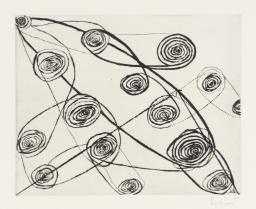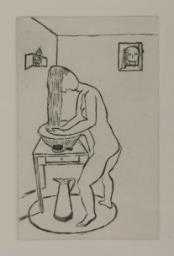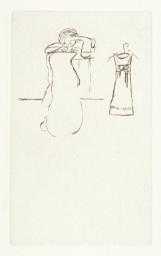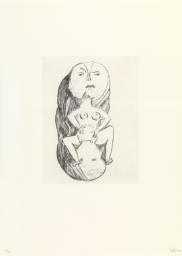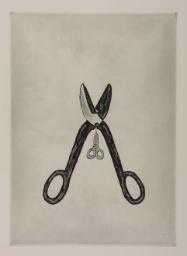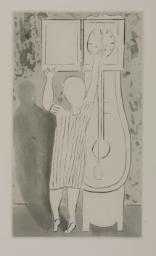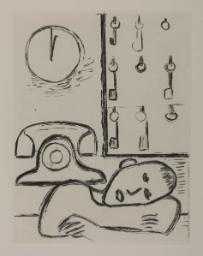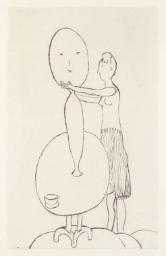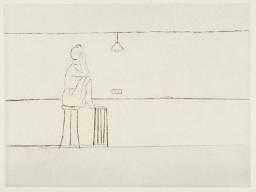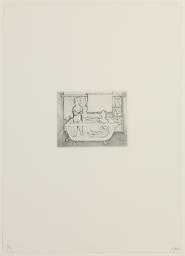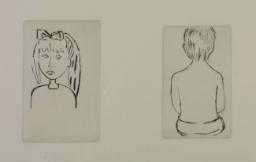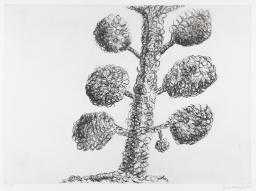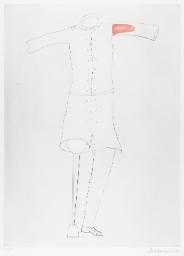
Not on display
- Artist
- Louise Bourgeois 1911–2010
- Part of
- Autobiographical Series
- Medium
- Drypoint on paper
- Dimensions
- Image: 119 × 225 mm
- Collection
- Tate
- Acquisition
- Purchased 1994
- Reference
- P77685
Summary
Paternity is one in a portfolio of fourteen drypoint etchings collectively titled Autobiographical Series. It depicts a bearded man in a tall chair with a swaddled infant on his lap. Lines coming from his right hand form an arrow pointing upwards, hinting at latent violence. To his right is a plant in a pot. The curl at the bottom of its stalk (which would normally disappear into the earth) together with its curved stance suggest a youthful flexibility in contrast with the more rigid, upright figure of paternal authority represented by the man in his high-backed chair. The plant surpasses the seated man in height, evoking the inevitable supplanting of the patriarch by his sons (or even daughters). Much of the emotional impetus for Bourgeois's work comes from feelings of anger and rivalry with her domineering father who carried on an affair with her English governess in the family home, thus depriving the young Louise of the potential to be first in his affections (after her mother). A significant work, The Destruction of the Father 1974 (Robert Miller Gallery, New York), was inspired by a fantasy of avenging the paternal domination of the family at mealtimes. Bourgeois and her husband, the art historian Robert Goldwater (1907-73), had two babies of their own in the early 1940s after adopting a little boy in 1939.
Through making art Bourgeois is able to access and analyse hidden (but uncomfortable) feelings, resulting in cathartic release from them. She has said:
Some of us are so obsessed with the past that we die of it. It is the attitude of the poet who never finds the lost heaven and it is really the situation of artists who work for a reason that nobody can quite grasp. They might want to reconstruct something of the past to exorcise it. It is that the past for certain people has such a hold and such a beauty ... Everything I do was inspired by my early life. (Destruction of the Father, p.133.)
Printmaking, like drawing, has been an important element in Bourgeois's artistic production. She first took it up in 1938, the year she moved to New York, and experimented widely with techniques and effects, producing an important portfolio of etchings titled He Disappeared into Complete Silence (The Museum of Modern Art, New York) in the 1940s. After a long break she took up printmaking again in 1973, the year Goldwater died. In the late 1980s Bourgeois began collaborating with workshops and publishers. She started to rework and reprint some of her old plates and to create new portfolios. Several of the images in the Autobiographical Series had already appeared in earlier forms. They range broadly in time and concept, encompassing both specific memories and more abstracted and ambiguous states of being. The portfolio was published in an edition of thirty-five plus ten artist's proofs by Peter Blum Edition, New York, and printed by Harlan & Weaver Intaglio, New York. See Tate P77682-4 and P77686-95 for the other images in the series.
Further reading:
Louise Bourgeois, Marie-Louise Bernadac, Hans-Ulrich Obrist, Destruction of the Father/Reconstruction of the Father: Writings and Interviews 1923-1997, London 1998
Louise Bourgeois, Lawrence Rinder, Drawings and Observations, exhibition catalogue, University of California, Berkeley 1995
Deborah Wye, Carol Smith, The Prints of Louise Bourgeois, exhibition catalogue, The Museum of Modern Art, New York 1994
Elizabeth Manchester
July 2001
Does this text contain inaccurate information or language that you feel we should improve or change? We would like to hear from you.
Display caption
Much of Bourgeois' work is autobiographical, and relates to her traumatic childhood. She idolised her mother, and loathed her overbearing, adulterous father. Bourgeois made her first prints in the 1940s and, after a gap of about forty years, returned to printmaking in 1990. Frequently child-like in style, these works portray the events and fantasies of her childhood and adolescence. The scenes include the trauma of birth, the pubescent discovery of the body, the moulding of a daughter by her mother, and the stifling of a daughter by her father.
Gallery label, August 2004
Does this text contain inaccurate information or language that you feel we should improve or change? We would like to hear from you.
Explore
- objects(23,571)
- furnishings(3,081)
-
- chair(915)
- actions: postures and motions(9,111)
-
- sitting(3,347)
- man(10,453)
- baby(526)
- birth to death(1,472)
-
- childhood(42)
- father and child(150)
You might like
-
Louise Bourgeois Untitled (Safety Pins)
1991 -
Louise Bourgeois Toilette
1994 -
Louise Bourgeois Sewing
1994 -
Louise Bourgeois Birth
1994 -
Louise Bourgeois Scissors
1994 -
Louise Bourgeois Woman and Clock
1994 -
Louise Bourgeois Sleeping Man
1994 -
Louise Bourgeois Man, Keys, Phone, Clock
1994 -
Louise Bourgeois Sculptress
1994 -
Louise Bourgeois Empty Nest
1994 -
Louise Bourgeois Woman with Suitcase
1994 -
Louise Bourgeois Children in Tub
1994 -
Louise Bourgeois Boy and Girl
1994 -
Louise Bourgeois Tree
1998 -
Louise Bourgeois Amputee with Peg Leg
1998

